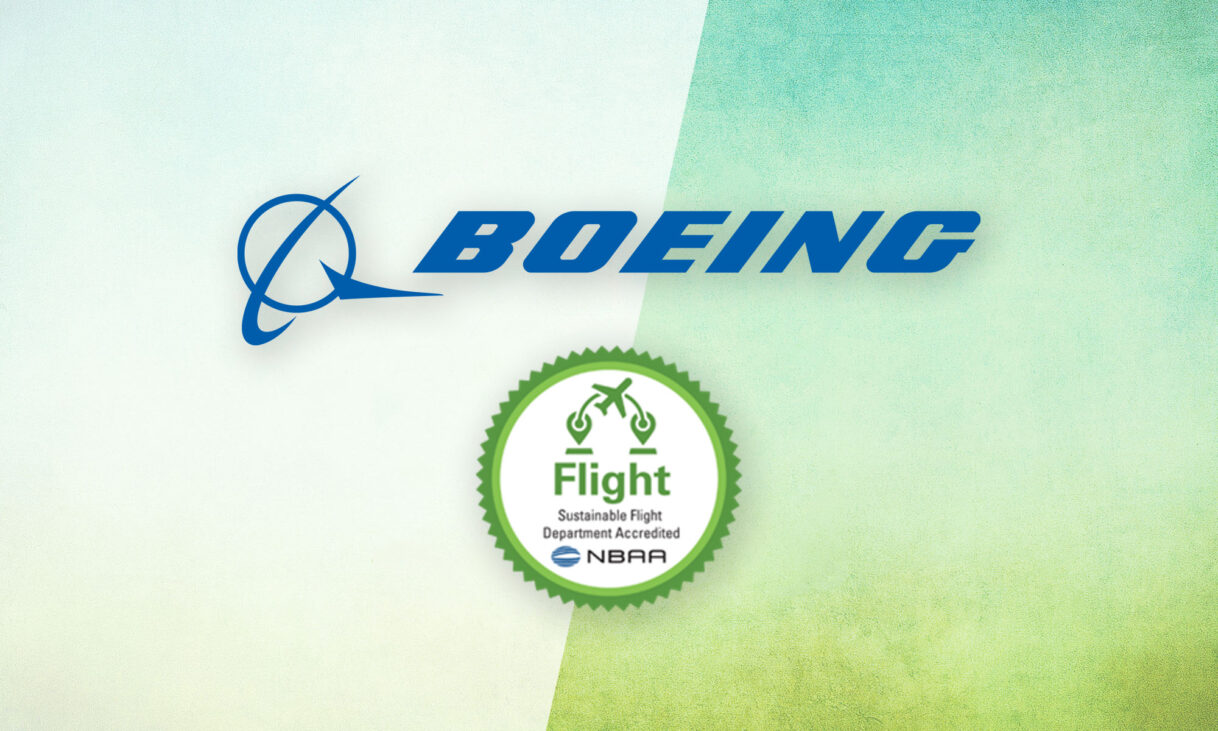
Company support and a motivated team drive the flight operation’s sustainability push
In the spirit of the bold climate ambitions shared by people around the globe, Boeing fully supports the aviation industry’s aim to achieve net zero carbon emissions by 2050. In January 2021, Boeing committed to delivering airplanes 100% compatible with SAF by 2030.
The company’s flight department supports these climate goals with its own commitments. In 2022, Boeing achieved NBAA’s Sustainable Flight Department Accreditation. The accreditation encourages companies in business aviation to better understand and reduce their environmental footprint.
“We saw the NBAA accreditation as a way to focus our efforts,” said Luke Bagato, a Boeing pilot and the department’s sustainability co-lead. “We had committed to addressing sustainability, and the accreditation provided an outline for how to create a strategy and document our progress.”
Assembling the Team
The first step was getting a sustainability team together within the flight department. With responsibilities for fuel procurement, Bagato already was studying the availability of sustainable aviation fuel (SAF). He volunteered to co-lead the team with Herta Grandsoult and Jim Michelau, who head the department’s recycling and waste reduction efforts in the air and at their facility.
“I don’t have an educational background in sustainability, but I wanted to be part of it,” said Bagato. “The desire comes first, learning comes later. You need a team of various subject matter experts within the department who want to take the lead on sustainability.”
The sustainability team included those with responsibilities for training and dispatch and another fuel expert. Where they lacked expertise, they leaned on Boeing’s corporate sustainability team.
Leveraging Company Resources
In February 2023, Boeing announced it had agreements to purchase 5.6 million gallons (21.2 million liters) of blended SAF produced by Neste to support its U.S. commercial airplane operations, including Dreamlifter flights and flight department travel. Through a book-and-claim process, this order displaces petroleum jet fuel with SAF in fueling systems outside the company’s fuel supply, providing environmental benefits where physical SAF is not available.
In addition to these flight operations improvements, the aviation department is partnering with the corporate sustainability team and Boeing facilities experts to cut emissions on the ground, with upgrades such as hangar ceiling fans, infrared water faucets, on-demand water heaters and LED lighting. Building on their 2022 NBAA Sustainable Flight Department Accreditation for flight, the Boeing team in 2023 will seek further accreditation in the infrastructure category.
As part of its companywide commitment, Boeing also launched a new series of aerospace sustainability training modules, which the flight department adopted. Corporate sustainability experts also helped with measuring emissions and sourcing market offsets.
Members of the flight department team now attend companywide biweekly sustainability briefings to further their education and network with experts in Boeing’s sustainability department.
“My advice would be to lean on your corporate sustainability leaders,” said Bagato. “They have dedicated their careers to this, and they are happy to help.”
Starting Small Yields Big Results
With the measurement in place, Boeing committed to double-digit SAF usage over the flight department’s baseline year by the time they renewed their NBAA accreditation. The biggest driver of emissions cuts would come from various formats of SAF. Usage targets are flexible, as the company concentrates on the benefits of book-and-claim, with physical uplift of SAF not always available.
The flight department wrote several other procedures, each of which reduce emissions a small percentage, but all add up: aircraft stock reviews to lower takeoff weight, limiting usage of auxiliary power units (APUs) and eliminating more paper waste.
As Bagato’s team worked through the NBAA framework, they discovered some procedures already adopted were helping meet emissions goals.
“We already had made some adjustments to lower the speeds we fly at – purely for fuel economy – and were using ForeFlight to adjust our altitudes for engine fuel burn efficiency,” said Bagato. “When we captured that with our sustainability analysis, we saw the dual benefit.”
Reaching the Finish Line
A major part of any sustainability strategy is a vendor analysis. For Boeing, that work is ongoing. The flight department identified a few vendors to engage in a dialogue about reducing packaging, relying more on electric ground power and other measures.
As technology catches up with Boeing’s sustainability vision (increased availability of SAF, more efficient engines and more direct routing, for example), Bagato sees reductions continuing, accelerating positive impacts.
In the meantime, a new quarterly sustainability newsletter for the flight department and the NBAA accreditation do more than recognize all the work the staff is investing, this outreach also encourages new ideas and broader participation, making the work easier.


 International Business Aviation Council Ltd.
International Business Aviation Council Ltd.